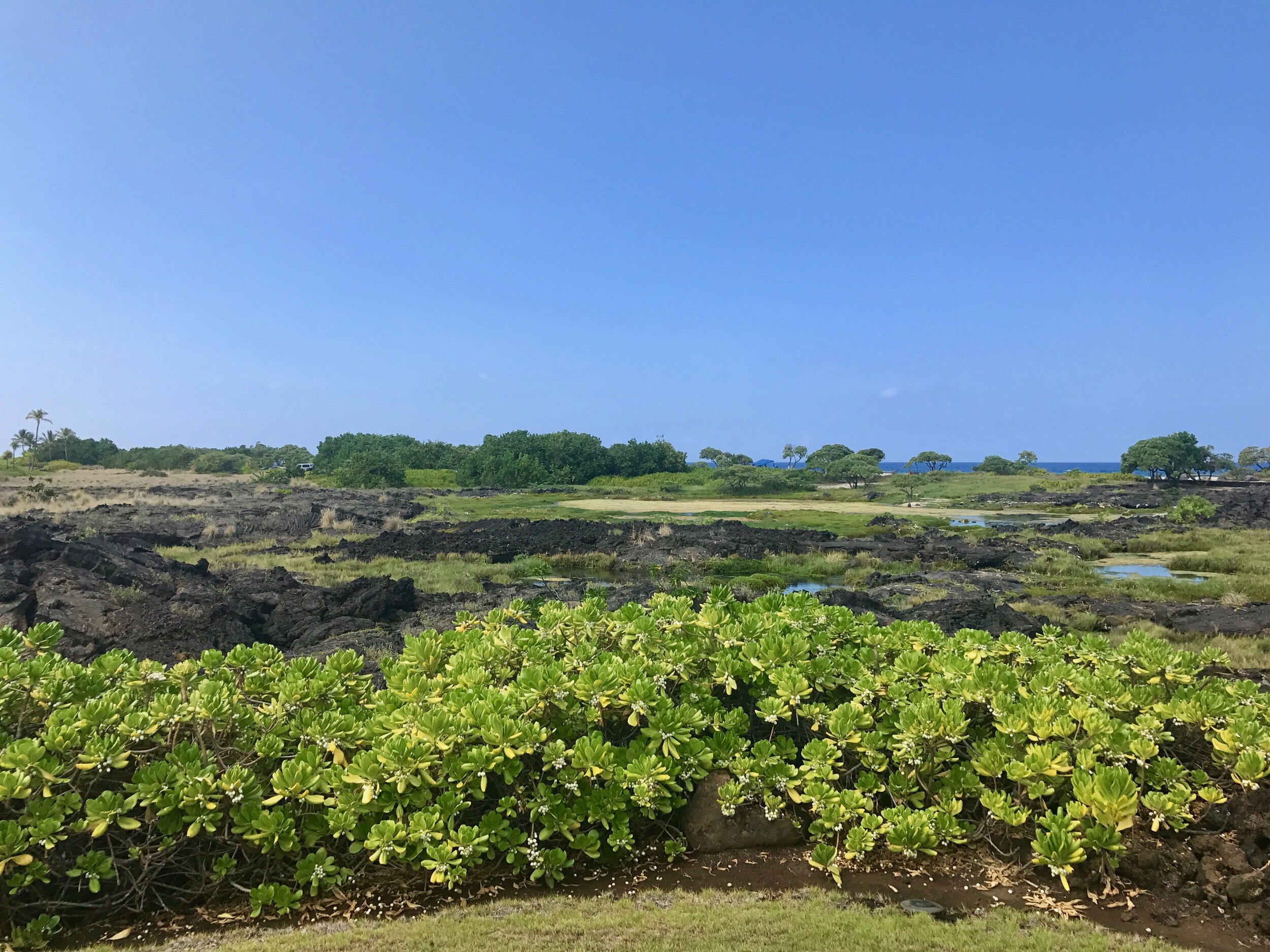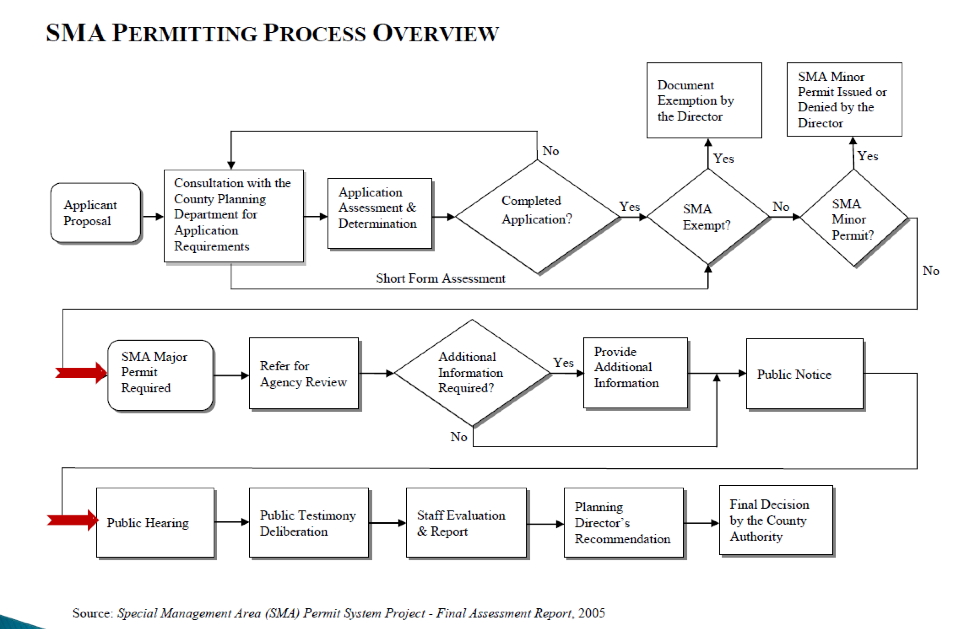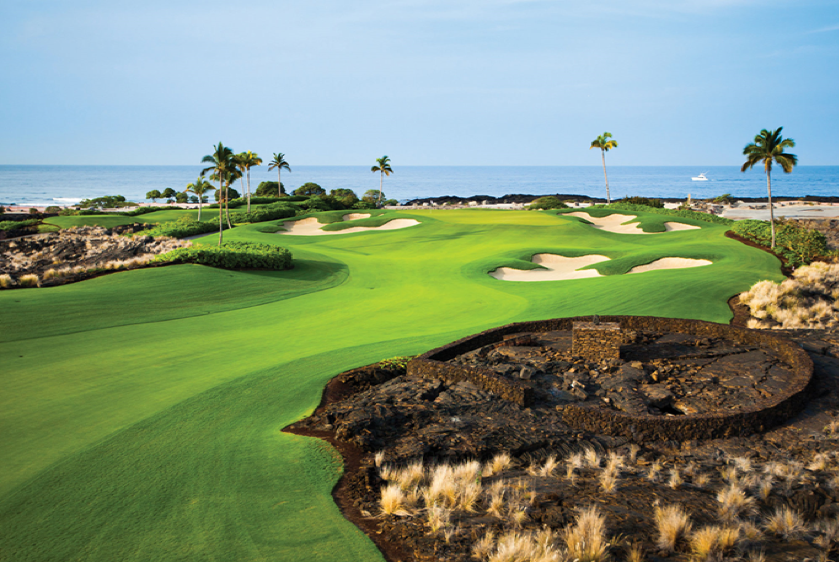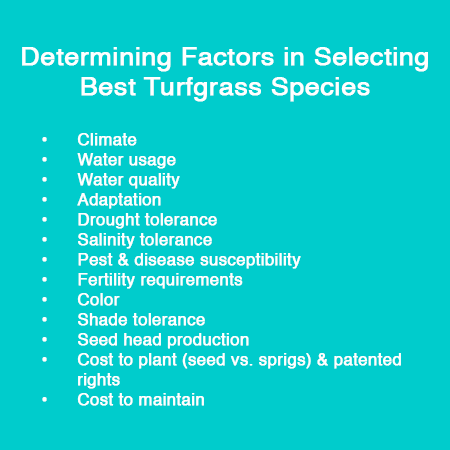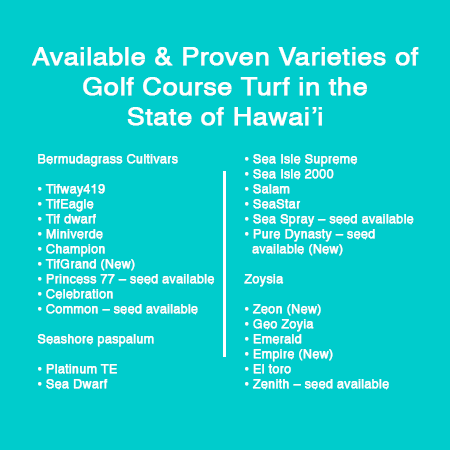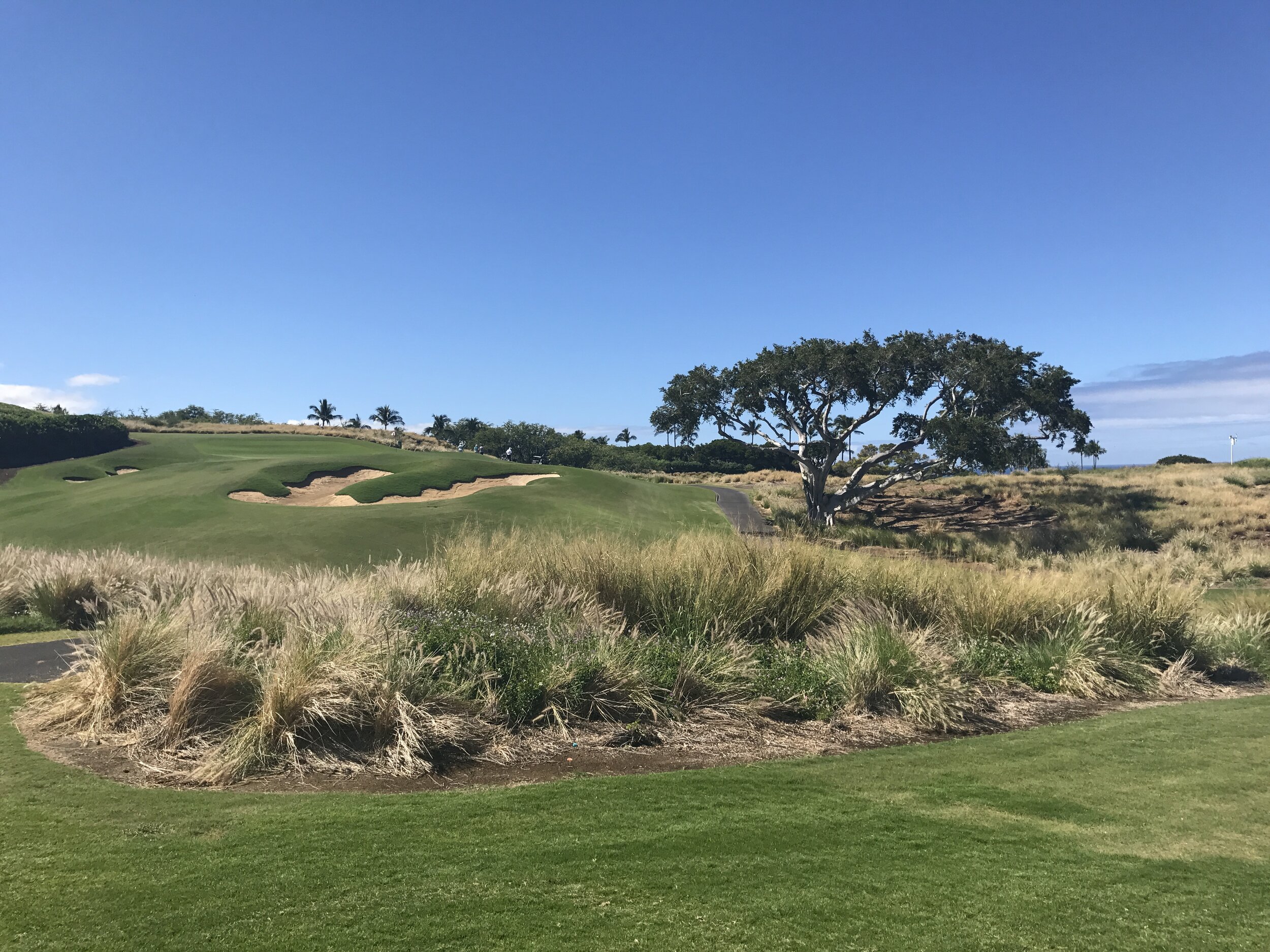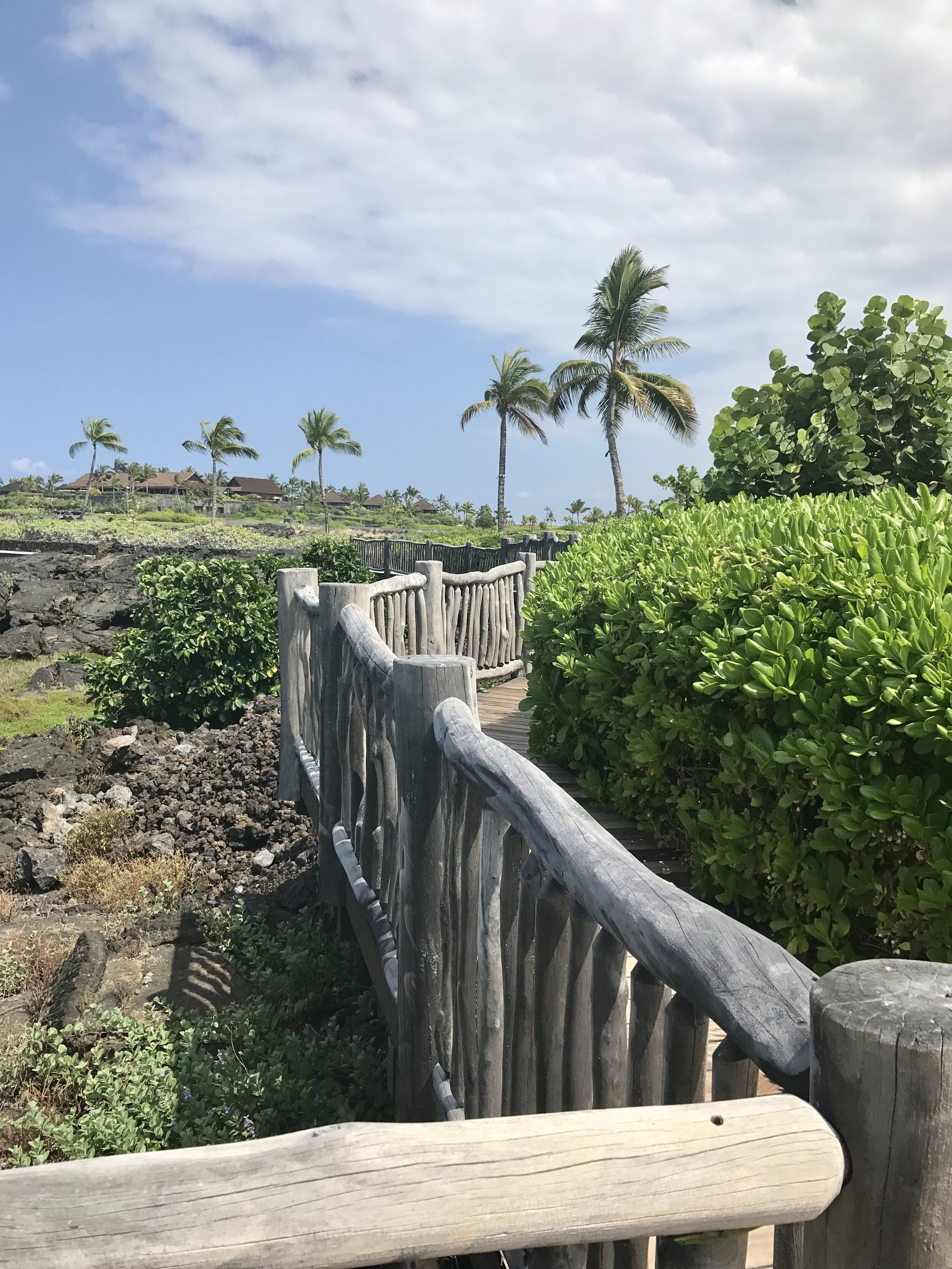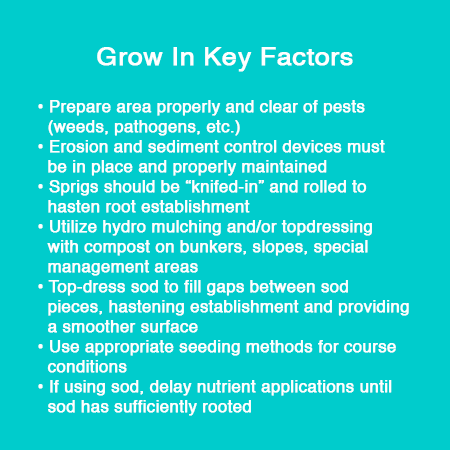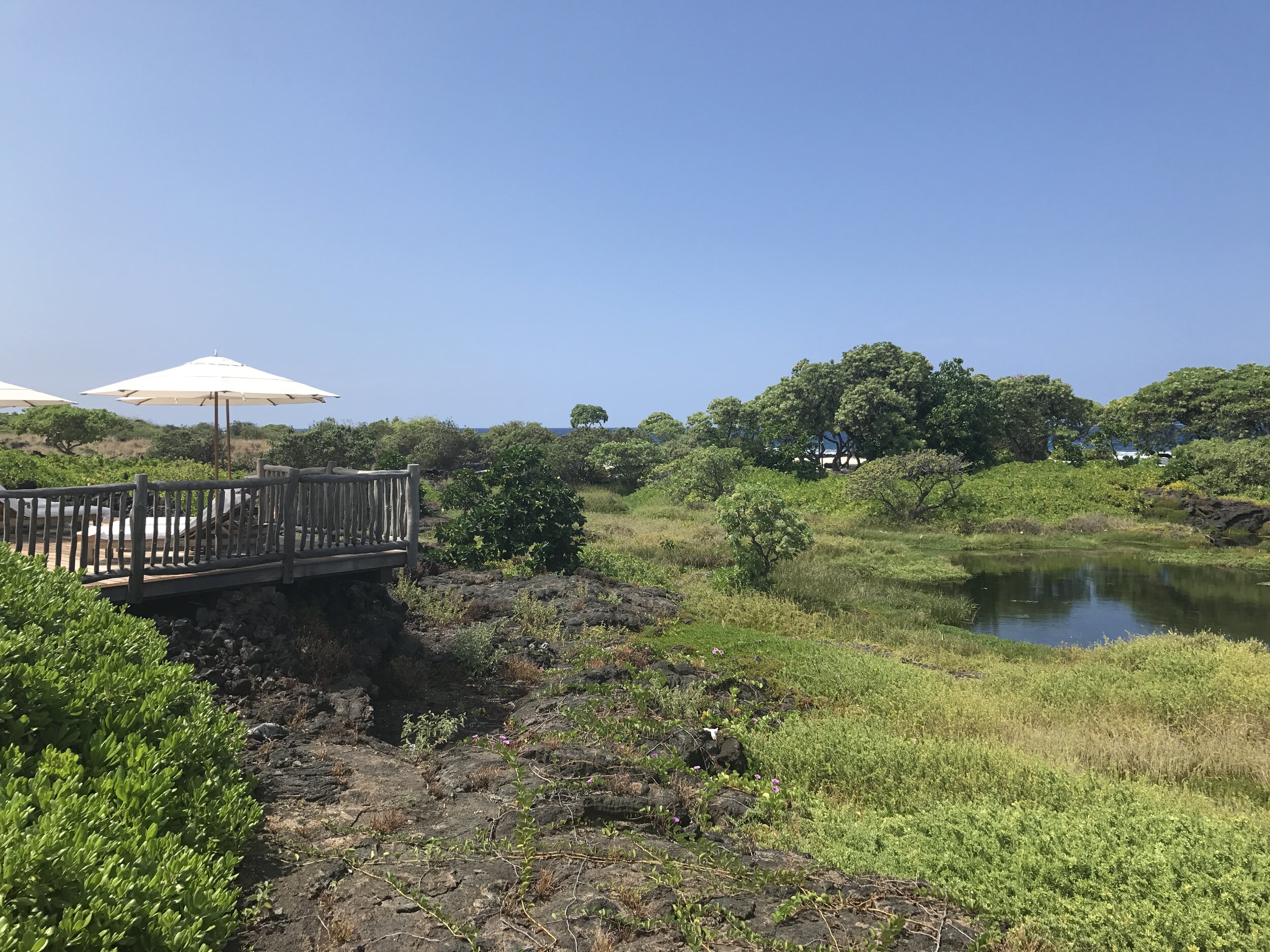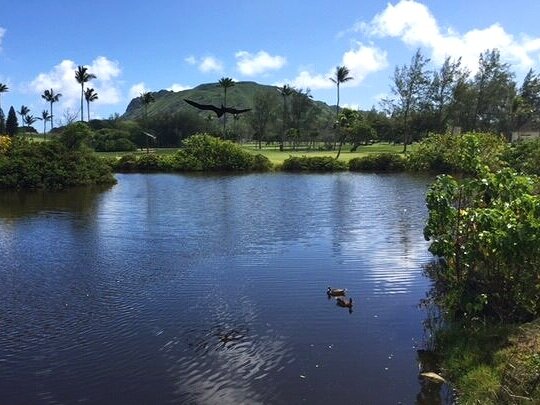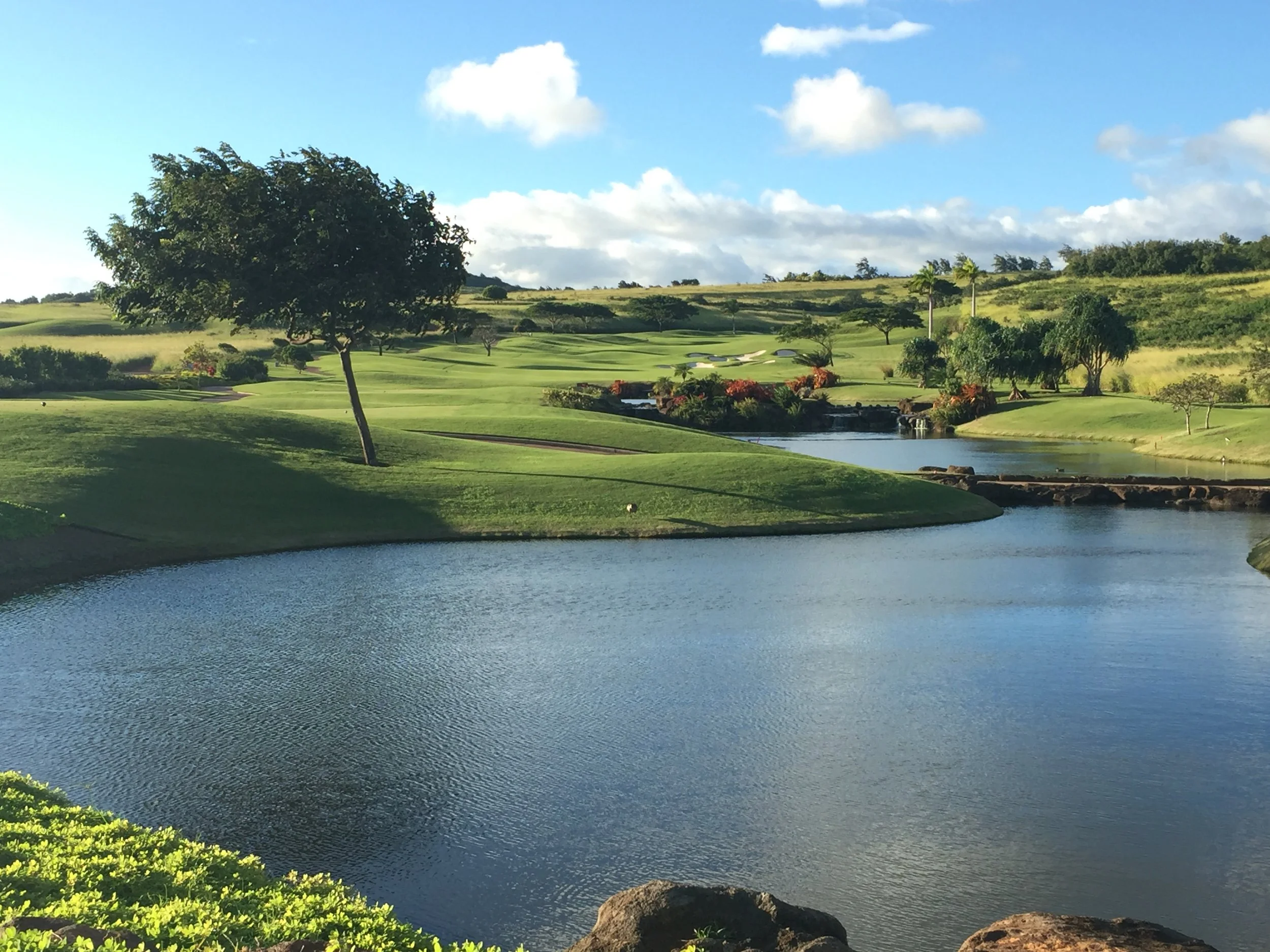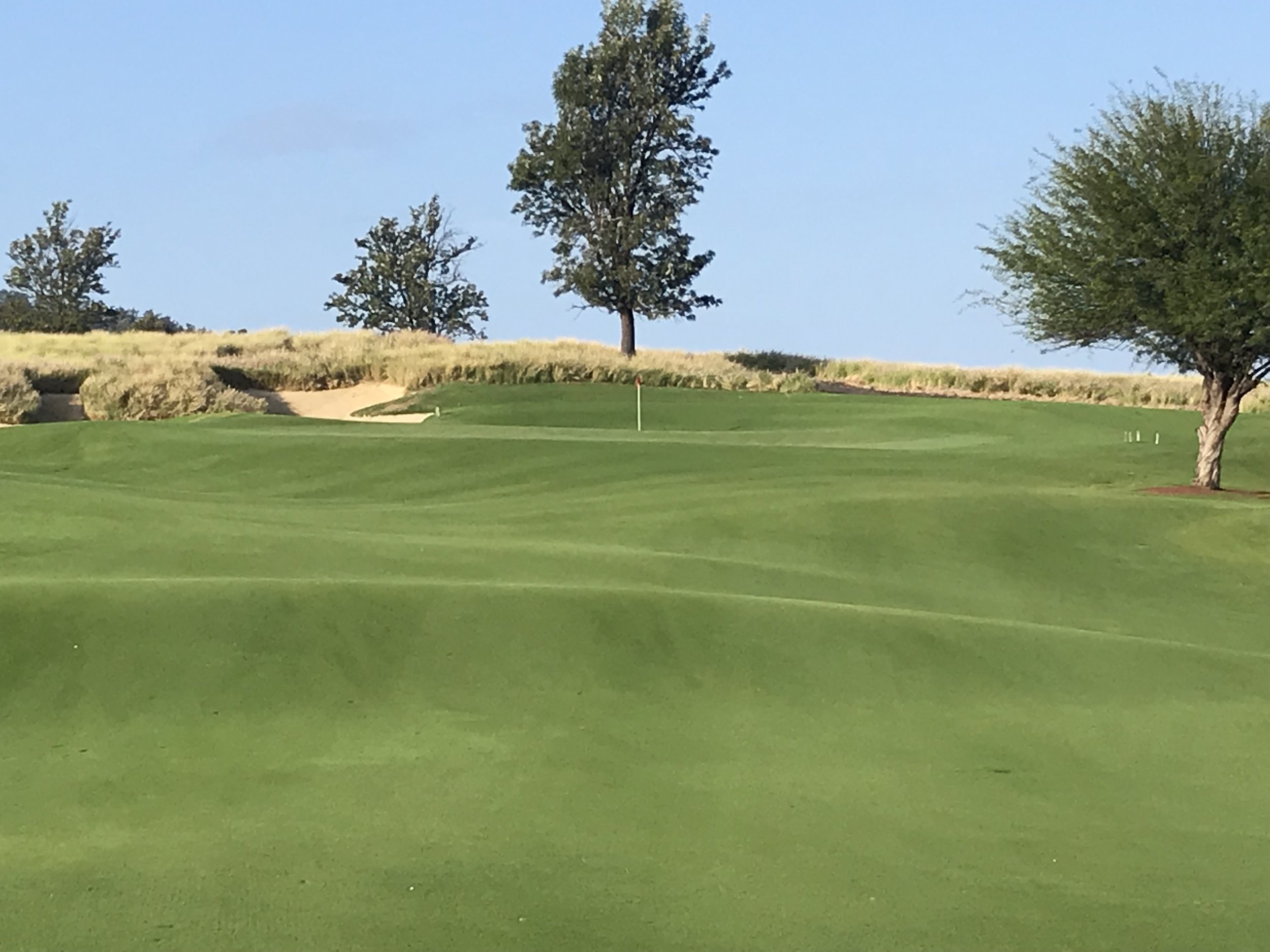1 - Planning, Design, and Construction

Considerate use of BMPs during planning, design, and construction should result in an environmentally sustainable golf course that operates efficiently and has minimal effect on the environment.
Building a new golf course or renovating an existing golf course requires careful consideration and understanding during planning, design, and construction. Designers can draw inspiration and develop a balanced, functional design through extensive evaluation. Evaluation includes onsite and neighboring ecological features, water resources, habitat documentation, topography analysis, physical settings, historic and cultural use of the land through involvement of lineal descendants, and a variety of other constraints and attributes.
There are differences between every golf course location and project, resulting in considerable variance in the design process and vision. The native volcanic substrate can differ drastically from island to island. The approach outlined is general and may not be applicable to all situations, however it provides a framework for sound decision-making throughout each project phase.
PLANNING
Proper planning is essential from an environmental, economic, and social perspective. Good planning provides opportunities to maximize and integrate environmentally favorable characteristics into the property. It also minimizes expenses resulting from unforeseen construction requirements. Planning that integrates archaeological, cultural, and historical sensitivities is equally important in Hawai’i and essential for community relations. Careful planning requires the involvement of a qualified team of internal and external stakeholders.
Planning, Design, & Construction: Internal and External Stakeholders
Golf course architect
Golf course superintendents
Civil engineer
Agronomist
Irrigation designer & engineer
Landscape architect
Clubhouse architect
Ecologist
Entomologist
Geologist
Soil scientist
Environmental engineer
Archaeologist
Land planner
Golf course builder
Energy analyst
Cultural advisory team
Resource management team
Consultants/Legal team
Public relations professional
Determine the objectives for construction prior to getting started. Objectives should be well-defined, measurable, and time-bound. Complete a feasibility study to identify needs, resources, obstacles, strengths and weaknesses of potential site(s), possible environmental and cultural impacts, potential opposition to development, timeframes, cost estimates, and expected return on investment. Consider whether needs are feasible given existing resources. Select an appropriate site that can achieve the needs of stakeholders and ideally exhibits features that contribute to a “Wow Factor”.
Access to Resources
Incorporate an understanding of topography and access to water, energy, labor, and material sources into the plan. In Hawai’i these components are particularly important given challenges associated with limited access and resources. For example, materials that need to be transported from the mainland or internationally could impact completion time, logistics, and costs. Labor could be limited based on existing construction projects on-island and/or time of year; this can impact costs and completion time. Also, understand state, county, and city regulatory requirements and/or restrictions in regards to construction, labor, and logistics.
Sensitivity to Plant and Animal Species
Golf courses provide vast areas of green space. In counties like Oahu or Maui with significant urban development, native areas have been eliminated to make way for increased infrastructure. Impermeable surfaces including concrete, asphalt, and office buildings often dominate urban areas. Golf courses provide acres of green space helping to reduce the urban heat island effect, providing surface water filtration, and supporting habitat for wildlife and ecosystem function. In places like the Big Island, where significant lava rock areas exist, there is limited green space. Courses have designed ways to build on crushed lava rock, making the area home to plants and wildlife. Maintaining habitats on golf courses improves biodiversity for our islands.
Part of the planning phase includes identification of rare, protected, endangered, or threatened plant or animal species on the site, including species the state deems “of special concern”. Determine whether any species are endemic. Examples include the Maiapilo (Capparis sandwichiana) and the Hawaiian Coastal Bee (Hylaeus anthracinus). Reference the US Fish and Wildlife Service to identify species federally protected under the Endangered Species Act and develop a long-term protection plan that preserves, promotes, or expands critical habitat.
Remove nuisance and exotic/invasive plants that have been identified as pests and replace with native species adapted to the site, based on site needs and preference. Maintain clearance between the ground and lowest portion of a fence or wall to allow wildlife to pass, except in areas where feral animals need to be excluded. Retain dead tree snags for nesting and feeding sites, provided they pose no danger to people or property.
Assess and identify wildlife habitat requirements (food, water, cover, space). Implement operations and areas that preserve wildlife habitat and migration corridors. Design and locate cart paths to minimize environmental impacts. Design unavoidable crossings to accommodate wildlife movement.
Construct and place birdhouses, bat houses, nesting sites, and beehives in out-of-play areas. Plant butterfly gardens around the clubhouse and out-of-play areas. Retain riparian buffers along waterways to protect water quality and provide food, nesting sites, and cover for wildlife. Minimize stream or river crossings to protect water quality and preserve stream banks. Reference Pollinator Protection and Wildlife sections for additional BMPs.
Regulatory Considerations
Research and understand local and state regulations which may be in place at the site. Early engagement between developers, designers, local community groups, and permitting agencies is essential to designing and constructing a golf facility that minimizes environmental impact and meets the approval process.
The construction phase poses the greatest risk of ecosystem alteration. With proper planning and design, golf facilities can be constructed and maintained with minimal impact to existing wildlife and their habitat. A Special Management Area (SMA) permit is essential for any shoreline-intended development and construction. This permit must be obtained and is available through the Coastal Zone Management Department Program by Hawai’i State Office of Planning. A civil fine of up to $100,000 (or $10,000 per day) could be enforced for violations. Reference for more information: http://files.Hawai’i.gov/dbedt/op/czm/program/sma/SMA-Permit-Short.pdf
DESIGN
Proper design will meet the needs of stakeholders, protect the location’s environmental resources, and be economically sustainable. Retain a qualified Director of Agronomy, golf course superintendent, and project manager at the beginning of the design and construction process to integrate sustainable maintenance practices in the development, maintenance, and operation of the course. Design to minimize the need to alter or remove existing native landscapes. Routing should identify areas that provide opportunities for restoration and retain as much natural vegetation as possible. Where appropriate, consider enhancing existing vegetation through supplemental planting of native vegetation/materials adjacent to long fairways, out-of-play areas, and along water sources supporting fish and other water-dependent species. Nuisance, invasive, and exotic plants should be removed and replaced with native species that are adapted to the site.
Selecting Turfgrass
Select a turf species/variety that meets the needs of stakeholders while adhering to the principle of “right plant, right place.” Create turfgrass research plots and/or a research green to test for the desired species and cultivars for density, color, and tolerances. In regards to selecting one species and cultivar versus multiple, consider whether the maintenance team will be able to keep the greens pure and uncontaminated long-term. One species is usually a cost-effective selection. The approach surrounds, tees, fairway, and rough height-of-cut are usually determining factors. Blends, or multiple species, are not commonly practiced, except at higher elevation golf courses (e.g., Makalei Hawai’i Island). Multiple species and cultivars can be a nuisance long-term and contaminate planted areas. Plant only certified turfgrass and check for the most updated restrictions of turfgrass propagation and cultivation.
Aesthetic Turf
Turfgrass may be used for purely aesthetic reasons to provide a pleasing view around clubhouses, entries, and other areas. However, remember that turfgrasses provide minimum wildlife benefits and require considerable maintenance inputs. Use turf as a landscape element where needed, designing for ease of maintenance and keep in mind that building shade and tree canopy can negatively impact health and function of turf.
Landscape & Garden Areas
Landscape (non-play) areas are an essential part of the overall course design, providing enhanced course aesthetics, wildlife habitat, external sound/noise abatement, and natural cooling. An environmental landscape design approach addresses environmentally safe and energy-saving practices; and is economically important. The fundamental principle for the environmentally-sound management of landscapes is RIGHT PLANT, RIGHT PLACE.
Choose the most stress tolerant species or cultivar for your area. Know the ultimate sizes and growth rate of trees, shrubs, and ground covers. This reduces the need for pruning and debris removal, and lowers maintenance costs. Non-play areas require a mix of sun and shade, optimal soil conditions, and adequate canopy air movement to sustain growth and function. Use “xeriscape” landscaping and native drought tolerant plants where feasible around buildings, parking areas, or other appropriate places. In most instances, established, drought-tolerant landscape plants have a root system substantial enough to keep them alive with little or no supplemental irrigation. Consider the use of water-holding polymers, water-sorbing polymers, or water storing crystals as means of water retention and reducing water loss to evaporation. Use mulches in shrubs and flower beds to reduce water evaporation losses. The use of rocks, sand, gravel, volcanic cinder or lava, and decorative pebbles have functional aesthetic purpose and conserve water.
Greens
When designing greens, select a location with adequate sunlight to meet plant-specific needs and sufficient drainage. Work with the architect to determine total greens size. The average total greens area in Hawai’i is approximately four acres. The greens size is determined by gauging the appropriate number of hole locations. Greens should be large enough to accommodate traffic and play, while remaining sustainable using existing resources.
Select an appropriate root-zone material as designated by the USGA. Sand blended with peat moss should be sent to a soil testing facility for analysis. Sand base and future topdressing sand should be from the same sand source. Determine whether to incorporate a greens sand liner and install tracer wire to maintain greens shapes long-term. Install yardage reference points for consistency when selecting hole locations.
Greens should be irrigated separately from surrounding turf. Consider designing greens to receive water from a potable water source separate from the main water source if water quality is poor.
Bunkers
For bunker design, understand the planned number of bunkers as it relates to resources available for daily maintenance. Bunker reduction and added native areas can save both resources and water. Additional design factors include determining bunker entry and exit points, wear patterns, and creating adequate space for ingress/egress points on greens, tees, fairways, and bunkers. Also decide what type of drainage the bunkers will contain.
Bunker construction includes preparation, creating slopes and shapes, deciding whether to use sod or sprigs or a combination, and calculating the cost to maintain the bunkers. It’s also important to consider what long-term maintenance will be required. Lastly, identify how to prevent against soil, rocks, or sediment from getting into the bunkers.
When it comes to bunker sand, select the proper color, size, and shape to meet your needs. Availability and sand analysis are keys for determining the ideal penetrometer rating and drainage characteristics.
Tees & Approaches
Tees and approaches are commonly constructed with cinder soil or are sand-capped. Minimizing the size of Tee Complexes can reduce maintenance costs. Understanding the long term objective of play levels can assist in determining the projected space requirements - too small for heavy play levels or too big for low play levels may have significant long term financial and resource impacts. Be sure to determine the size for each and what type of mower will be maintaining these areas.
Fairways
Landing areas should be considered when working with the architect to determine the size of each fairway. In Hawai’i, total fairway areas have been trending larger than rough areas.
Rough
Work with the architect to define play and non-play maintenance boundaries. Consider adding more sprinklers on the perimeter edge to combat potential wind and help conserve water.
CONSTRUCTION
Construction should be completed with care to minimize environmental impact and financial ramifications. Permitting must be complete and abided by, especially in Special Management Areas. Use only qualified contractors who are experienced in the special requirements of golf course construction.
Guide contractors to ensure optimal safety and environmental preservation; conduct a pre-construction conference with relevant stakeholders. Maintain a construction progress report and communicate the report to the proper permitting agencies.
Schedule construction to maximize turfgrass establishment and site drainage, environmental conservation, and resource management. Build temporary construction compounds in a way that minimizes environmental impacts. Use environmentally sound construction techniques and soil stabilization techniques to minimize erosion and maximize sediment containment.
Establishment of ground water testing protocols as well as coastal water sites before, during, and after construction will assist in assuring any potential impacts to the environment are actively observed and managed. Testing sites on properties where elevations vary should include testing sites above and throughout the gradient of the property to ensure impacts outside and on the site can be mitigated and properly recorded. Testing protocols should be determined in advance, including testing intervals for each site based on sensitivities toward surrounding features, ground water flows, proximity to drinking wells, coastal impacts, and other related factors.
Grow-In
Turfgrass establishment is an important and unique phase in turfgrass growth. It can require greater quantities of water and nutrients than established turfgrasses, care should be taken to minimize environmental risk. Special Management Areas may require a different approach and should be calculated.
A “Grow-in” Fertility Program is usually recommended by the agronomist or superintendent and should create calculated rates of pre-plant and establishment nutrient guidelines. Soil test reports of the topsoil or sand base should identify amendments and nutrient requirements for pre-planting. The normal establishment period can range from three to six months and nutrient input can accelerate or create potential pollutants if a BMP is not followed. In parts of the state where soils used for turf establishment consist of extremely porous materials such as sand or crushed lava, extreme care should be used to avoid the use of too much water that can move applied nutrients out of the grow-in zone and into waterways, coastal areas, and down gradient areas.
During the establishment period, mow as soon as the sod has knitted-down, when sprigs have rooted at the second to third internode, and seedlings have reached a height of one-third greater than intended height-of-cut. Most agronomists or superintendents will create a timeline when areas are planted to give consistent time for establishment.
Heights of cut will also be determined by the establishment period timeline as turf becomes established, and will be managed depending on area. Light verticutting and topdressing will improve playing surface and assist when reducing height-of-cut in each turf area. Reducing the height-of-cut often reduces weed establishment. Improper herbicide application timing can slow down turf establishment; consider spot application versus wide-spread applications.
Erosion and Sediment Control
Soil carried by wind and water erosion may transport contaminants with it. Contaminants can dislodge, especially on entering water bodies, where they can cause pollution. Erosion and sediment control are critical components of construction and grow-in. Develop a working knowledge of erosion and sediment control management, work with the contractor to ensure proper steps are taken and state requirements are being followed in regards to types of structures, materials, and design features.
Develop and implement strategies to effectively control sediment, minimize the loss of topsoil, protect water resources, and reduce disruption to wildlife, plant species, and designed environmental resource areas. Hydro-seeding, hydro-mulching, and sodding offer soil stabilization and assist in water retention and erosion control. Reference Surface Water Management and Water Quality Protection Section for additional BMPs. Reference for more information:
http://health.Hawai’i.gov/cwb/clean-water-branch-home-page/standard-npdes-permit-conditions/
Wetlands
Most states consider wetlands “waters of the state,” a designation that carries significant legal ramifications. Permitting requirements for wetlands can have multiple overlapping jurisdictions of federal, state, and local agencies. At the federal level, the U.S. Army Corps of Engineers (USACOE), EPA, U.S. Fish and Wildlife Service (FWS), National Oceanic and Atmospheric Administration (NOAA), and maritime agencies may be involved. State agencies that may be involved in wetlands include the Hawai’i Department of Land and Natural Resources (DLNR) and the Department of Health (DOH).
Wetlands act as filters for pollutant removal and as nurseries for many species of birds, insects, fish, and other aquatic organisms. The biological activity of plants, fish, animals, insects, and especially bacteria and fungi in a healthy, diverse wetland is the recycling facility of our ecosystem. When incorporated into the golf course design, wetlands should be maintained as preserves and separated from managed turf areas with native vegetation or structural buffers. Constructed or disturbed wetlands may require a permit to be an integral part of the storm water management system. Ensure proper permitting has been obtained, properly delineate, and establish buffer zones and erosion control before working in, and around, wetlands. Reference Surface Water Management and Water Quality Protection section for additional BMPs.
Drainage
Adequate drainage is necessary for growing healthy grass. Damaged, improperly installed, or poorly maintained drainage systems will result in inferior performance that negatively impacts play and increases risks to water quality. A comprehensive drainage plan addresses containment of runoff, adequate buffer zones, and filtration techniques in the design and construction process to achieve acceptable water quality.
Subsoil preparation, gravel placement, slopes, and backfilling are important in constructing drainage systems. Internal golf course drains should not drain directly into an open water body, but should discharge through pretreatment zones and/or vegetative buffers to help remove nutrients and sediments. Proper drainage and storm water management devices, such as vegetative buffers or swales should be deployed. The drainage system should be routinely inspected and maintained to ensure proper function. Reference Surface Water Management and Water Quality Protection section for additional BMPs.
Surface Water: Storm Water, Ponds, Lakes, Coastal Waters
Controlling storm water on a golf course prevents flooding of facilities and play areas, plus controls amount and rate of water leaving the course. Storm water control also involves storing irrigation water, controlling erosion and sediment, enhancing wildlife habitat, and addressing aesthetic and playability concerns.
Storm water on a course may not originate from the course, but from adjoining lands, including residential or commercial developments. An environmental benefit that golf courses provide includes filtering storm water naturally to remove waterborne pollutants through planned “treatment trains” (i.e., vegetated swales, depressed landscape islands, and constructed wetlands). DOH’s Clean Water Branch can be of assistance with understanding State rules and regulations. Reference Surface Water Management and Water Quality Protection section for additional BMPs.
Maintenance Facilities
Maintenance facility design and construction should promote positive environmental impact, health, and wellness. Ensure proper placement of the pesticide mixing and storage facility, equipment wash pad, and fuel center to minimize potential for contamination of soil and water resources. Locate operations away from groundwater wells and areas where runoff may carry spilled pesticides into surface waterbodies. Do not build new facilities on potentially contaminated sites. An open building must have a roof with a substantial overhang (minimum 30° from vertical, 45° recommended) on all sides. Other considerations include ensuring optimal ventilation, lighting, space, logistics, and energy efficiencies.
Design and build pesticide storage structures to keep pesticides secure and isolated in a roofed concrete or metal structure with a lockable door. Construct floors of seamless metal or concrete sealed with a chemical-resistant paint. Ensure that flow from floor drains does not discharge directly to the ground and that drains are not connected to the sanitary sewer line or septic system, they should drain to a contained sump. Equip the floor with a continuous curb to retain spilled materials. Provide storage for personal protective equipment (PPE) where it is easily accessible in the event of an emergency, but do not store PPE in the pesticide storage area.
Additional Maintenance Facility Construction Considerations:
Provide adequate space and shelving to segregate herbicides, insecticides, and fungicides
Use shelving made of plastic or reinforced metal; keep metal shelving painted; do not use unsealed wood
Provide appropriate exhaust ventilation and an emergency wash area
When constructing a concrete mixing and loading pad, concrete should have a water-to-cement ratio no higher than 0.45:1 by weight
Sumps should be small and easily accessible for cleaning
Always store nitrogen-based fertilizers separately from solvents, fuels, and pesticides, since many fertilizers are oxidants and can accelerate a fire
Ideally, fertilizer should be stored in a concrete building with a metal or other type of flame-resistant roof
Store fertilizers in an area that is protected from rainfall
Storage of dry bulk materials on concrete/asphalt pad may be acceptable if protected from water flowing across the pad
Each piece of equipment should have an assigned parking area
Spill and decontamination kits are required for any golf course with a nursery (that grows own grasses); some pesticides are required to be secured by a lock and key; be sure to read all labels
Dry pesticides are to be stored above wet/liquid pesticides
Reference Pesticide Management, Maintenance Facility Operations, and Energy sections for additional BMPs.
External Certification Programs & Standards
Environmental management programs, health and wellness platforms, and environmentally-friendly building design can help courses protect the environment and promote community relations. These programs can help enhance the natural areas and wildlife habitats that golf courses provide and improve efficiencies. Obtaining certifications and adhering to standards can enhance community, member/guest, employee, and civic relations.
Certifications and internationally-recognized frameworks that golf courses and clubs can pursue range from environmentally-focused programs to certifications related to health and wellness. The State of Hawai’i has integrated the United Nations Sustainable Development Goals within its legislation. Aligning initiatives and operations with these goals helps create local and global impacts, and supports priorities of the State. Establish a communications plan to educate members/guests and the community of alignment with these standards or certifications. Reference GCSAA Environmental Institute of Golf for more information: https://www.eifg.org/





